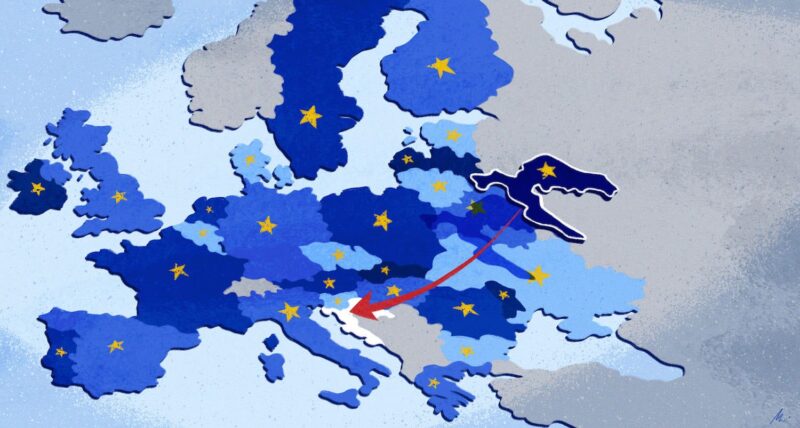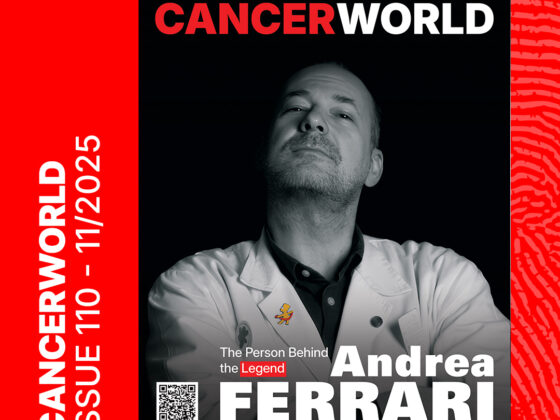Croatia has caught up with the rest of the EU in adopting a national cancer control plan. Sophie Fessl looks at how using EU guidance drawn from experiences of other member states helped them ensure it is relevant, patient-centred, and capable of implementation.
Croatia’s cancer survival rates are among the worst in Europe for many common adult tumours, including lung, prostate, breast, cervix, and colorectal cancer. Yet among the EU’s 27 member states, Croatia was, until recently, the only country without any national cancer control plan (NCCP). That has now changed, thanks to three years of inclusive efforts to develop a comprehensive plan tailored to the specific needs and resources of the country.
The Croatian National Cancer Control Plan covers the period 2020-2030. Its broad scope is demonstrated by the number of objectives it set — almost 150 of them. Its ambitions can be seen in the 284 different measures proposed, covering the full cancer care spectrum, from primary prevention to rehabilitation and reintegration, and palliative care. Its inclusive approach is evidenced by the involvement of 135 stakeholders, organised into 21 working groups.
\Though it still awaits parliamentary approval the Plan represents a beacon of hope for patients and the cancer community as a whole. It is also a testimony to the value of European collaboration, and specifically to the considerable work done by the European Partnership for Action Against Cancer (2009-2013) in sharing and analysing experiences with Europe’s existing national cancer plans, and developing a European Guide for Quality National Cancer Control Programmes that countries like Croatia have been able to draw on.
A tailored plan
While Croatia’s neighbours had already developed national cancer plans, the 21 groups working on the Croatian Plan focused on creating something that addressed their country’s specific challenges. “You cannot just copy-and-paste a cancer control plan,” says Eduard Vrdoljak, Professor and Head of the Oncology Centre at the Clinical Hospital in Split, who led the development of the Plan. “Every country is different, with different cancer burden, different quality of cancer care as well as differences in the healthcare infrastructure.”
Mark Lawler, Professor of Digital Health at Queen’s University Belfast and a Board Member of the European Cancer Organisation, sees this strategy as an asset. “One of the things we’ve pushed over the last five years is the need for data that informs decision making, and this shines through in the Croatian cancer plan. This idea of actually shedding light on the issues that are specifically relevant to Croatia, highlighting where Croatia is now and considering how the suggestions you want to implement will influence lives – that has been very carefully done here.”
“This idea of highlighting where Croatia is now and how the suggestions you want to implement will influence lives — that has been very carefully done”
Tit Albreht, Senior Health Services & Health Systems Researcher at the National Institute of Public Health, Slovenia, who led work on the European Guide for Quality National Cancer Control Programmes back in 2009-2013, is delighted at how far those recommendations were adopted in developing the Croatian plan. “The Plan is comprehensive, in that prevention, care and governance are all included.” It also addresses the challenges posed by the geography of the country and the distribution of medical centres. “The Plan achieves a good compromise between the need to concentrate care and decentralisation, which is possible for early detection and screening programmes.”
As Albreht points out, the task of developing a plan also offered a chance to take stock and address each aspect of the cancer trajectory, which is essential for planning and mapping resources. One notable inclusion in Croatia’s Cancer Plan is presented in the final chapter, which goes beyond mapping and planning resources, to offer a detailed analysis of the cost-effectiveness of the proposed measures. “In many cancer plans, the main problem is that no value is attached to the measures proposed,” explains Albreht. “[Such a] plan has a simple declarational value. When it confronts the reality, you suddenly see that there are problems, of course, because there is not enough money for this and that.” Apart from the cost analysis, the plan’s final iteration also contains indicators and targets, which allow for an assessment of impact.
The cost analysis compares the cost of implementing all proposed measures with the cost of implementing no measures at all. It takes into account not just the direct cost for medical care or screening programmes, but also indirect costs, such as costs of informal care, lost working days and productivity losses. “To implement all measures, Croatia would have to invest € 200 m, on top of existing expenditure for cancer,” says Vrdoljak. “At the same time, we would save 113,000 life years. This would give us a cost of €1,345 per QALY [quality-adjusted life years] gained.” (For purposes of comparison, that is almost 25 times lower than the threshold employed by the UK’s National Institute for Health and Care Excellence — around £30,000 — in deciding whether a health intervention should be funded.)
Lawler commends this approach. “It clearly shows what not having a proper cancer control plan would cost. And it makes sense for influencing government policy: Every expert looking at this will conclude that implementing this plan will save them money, rather than cost them money.”
“Every expert looking at this will conclude that implementing this plan will save them money, rather than cost them money”
This cost-effectiveness analysis also informed decisions on which measures will be prioritised. “While it is expensive to invest in oncology in general, especially drugs, tests and new units, it is rather cheaper to invest in implementing the plan, particularly in infrastructure, monitoring, reporting, and the continuous measurement of outcomes,” says Vrdoljak. Three areas of priority have been defined within the Croatian Plan: creating a national oncology network and patient registry; enhancing primary and secondary prevention; and improving access to modern radiotherapy.
A focus on impact
To keep minds focused on the impact proposals for the Cancer Plan would have on patients, patient advocates were involved in the working groups, with one advocate also serving on the national committee that steered the development of the Plan. Vesna Ramljak, President of breast cancer patient advocacy group Europa Donna Croatia, contributed to the work on diagnostics and treatment monitoring, as well as on pathology and molecular diagnostics. “Cancer patient advocates were one of the main drivers of the process of making and adopting a National Cancer Control Plan. We organised on an informal platform, and managed to include 18 patient representatives in 21 working groups.”
The big demand from the patient advocates, says Ramljak, was for systematic monitoring of treatment outcomes on a national level. This measure — also a key concern of healthcare professionals’ societies — was taken on board, says Vrdoljak. “Networking, database monitoring and reporting will allow us to continuously monitor the performance of measures — including the performance of new drugs introduced in the market.” The oncology network will connect all oncology institutes in Croatia, allowing the progress of each patient to be followed. “Every institute, every new drug, will be followed. When we introduce a measure, we will be immediately able to measure and monitor its effect. It’s the only way to create continuous information about quality of care and how to improve.”
“When we introduce a measure, we will be immediately able to measure and monitor its effect”
The intention is to collect data on how the measures proposed by the Plan fare in real life. “The plan should be a live document, continuously re-considered and re-written to accommodate all knowledge generated. In order to change, you have to know how good you are.”
Targeting preventable cancers
More than one-third of the overall burden of disease in Croatia can be attributed to behavioural risk factors, including smoking, alcohol use, physical inactivity and high BMI, according to 2015 estimates from the Institute for Health Metrics and Evaluation. Reducing cancer incidence to the average level of western EU countries by 2030, through primary prevention, is a priority. In addition to programmes that aim to change lifestyles and reduce behavioural risks, the Plan also proposes a population-based vaccination programme against HPV, the key cause of cervical cancer and some head and neck and other cancers.
Currently, Croatia has established screening programmes for breast, cervical, colon and lung cancer. The NCCP proposes to initiate screening programmes for prostate and gastric cancer and melanoma, and to improve the take-up rate of existing screening programmes. “Establishing a lung cancer screening programme will be an interesting experience, as Croatia has a relatively high prevalence of smoking,” notes Albreht, who suggests it could offer lessons for other countries. “If this runs successfully, we would expect to see tangible benefits very soon — probably already in four to five years.”
Access to quality care
The third priority is to improve access to modern radiotherapy and reduce waiting times. Estimates cited in the Cancer Plan suggest that, “out of 1,000 patients with cancer, 520 will be treated with radiotherapy and an additional 120 will receive radiotherapy repeatedly.” Currently, Croatia does not have sufficient radiotherapy devices, and those it does have are largely out-dated. The measures proposed include acquiring new linear accelerators, introducing devices for stereotactic body radiation therapy and brachytherapy, as well as training staff for implementing the new techniques.
Other proposals include re-organising cancer care, so that 90% of cases are considered by multidisciplinary teams for a joint decision on the best treatment option; raising the quality of cancer surgery by ensuring more than 80% of patients are operated by accredited oncology surgeons in accredited institutions; improving access to cancer drugs, with continuous monitoring of treatment outcomes and an expenditure within the average of western EU countries; and optimising healthcare for children with cancer by raising the quality of healthcare and providing families with psychosocial care. Albreht sees the latter proposal as a particular plus point for the Croatian Plan, as paediatric cancer and the provisions needed to adequately deal with it are often not specifically discussed, he says.
Two working groups were concerned with the ‘supportive’ side of cancer care: one focused on psychological support, rehabilitation and re-integration of oncology patients and the other on palliative care. “There was no active policy in this area,” says Ramljak. “Unfortunately, outside of patient support groups, institutional support care is sporadic. We hope this will change with the adoption of the NCCP.”
Ljiljana Vukota ‒ a breast cancer survivor and psychologist, coordinated the working group on psychological support, rehabilitation and re-integration. She takes pride in the extent to which “all important issues related to the quality of life of patients” were incorporated in the analysis of development of the Plan. “All aspects of treatment and living with the disease have been taken into account, but we are aware that in a situation of limited resources, the priorities in the implementation of the strategy will need to be well thought out.” She sees the Plan as a model for healthcare reform that should improve the way measures to improve quality of life are planned and implemented in Croatia. “Transparency and the ability to make timely decisions will be key to success,” and adds that a lot of ‘field work’ will be needed, given the complex geographical structure of Croatia and related challenges in managing healthcare and other public services.
Another area with extensive patient input was the development of palliative care, which Ramljak says is still hard to access. The vision formulated in the Cancer Plan is to provide equal access to high-quality palliative care, integrated into all levels of the healthcare system. Measures proposed include the establishment of new palliative care institutions, including mobile palliative care teams, and the education of healthcare professionals to work in palliative care. A national palliative care network is also planned. The proposals are another great plus point for Croatian Plan, says Albreht. “Psychosocial support and rehabilitation are important services that are… often not envisaged,” he says. “The Croatians are now trying to fill this gap, although it can be hard to have enough experts to address it.”
“Psychosocial support and rehabilitation are important services that are often not envisaged… The Croatians are now trying to fill this gap”
Support for research
One of the plus points noted by Lawler is the inclusion of cancer research. “If research is not included in a cancer control plan, we potentially miss the innovation part of the cancer control agenda. In order for cancer patients to get access to innovation in both diagnosis and treatment, it’s important that research and innovation is emphasised,” he says, adding that the priorities for research need to be tailored to local requirements. “In an analysis of the research agenda in the region, we found that in some situations, the focus on cancer research — and particularly the diseases that were focused on — didn’t always reflect what were the important issues for the region. For example, colorectal, gastric, lung and pancreatic cancer are significant issues in the region, and yet they were being under researched.”
Although Croatia’s Cancer Plan envisages an increase in cancer research carried out in the country, the plan does not define the topics. One measure defined in the Plan is to “Establish a scientific unit in each clinical hospital center that will have the task of achieving a relevant translation project.” The criteria for ‘relevance’ are not defined in the Plan.
Taken together, Croatia’s National Cancer Control Plan is comprehensive and very promising, concludes Albreht. But as he points out, the main challenge is not to write the plan, but to implement it. “Implementation can go wrong in so many ways, and even trivial aspects matter.”
While it has now been adopted by the government, the Plan ‒ and the budget to finance it ‒ still awaits approval by Parliament. Ramljak is hoping for the best. “Although all resources in Croatia’s healthcare system are targeted toward Covid-19, thanks to the efforts of cancer patient organisations we have managed to raise interest for the NCCP. We are highly optimistic about the NCCP becoming a reality and serving as a base for focused problem-solving in cancer.” She’s not expecting “a magic wand”, she says, but hopes that the hard work of implementing the plan can soon start, “so we could achieve positive change in results in cancer care and outcomes of cancer care.”
This article was changed on 8 December 2020 to reflect recent developments in the status of the Plan.
Illustration by Maddalena Carrai












